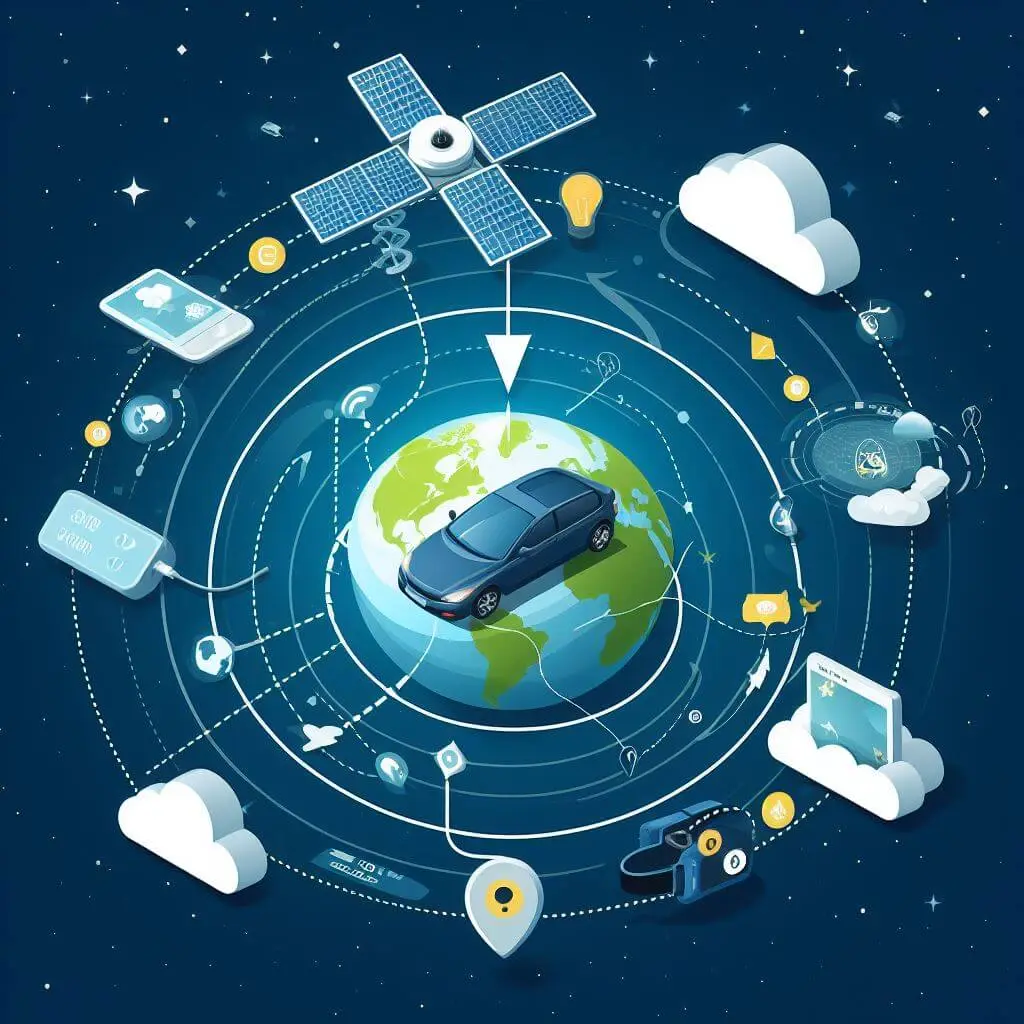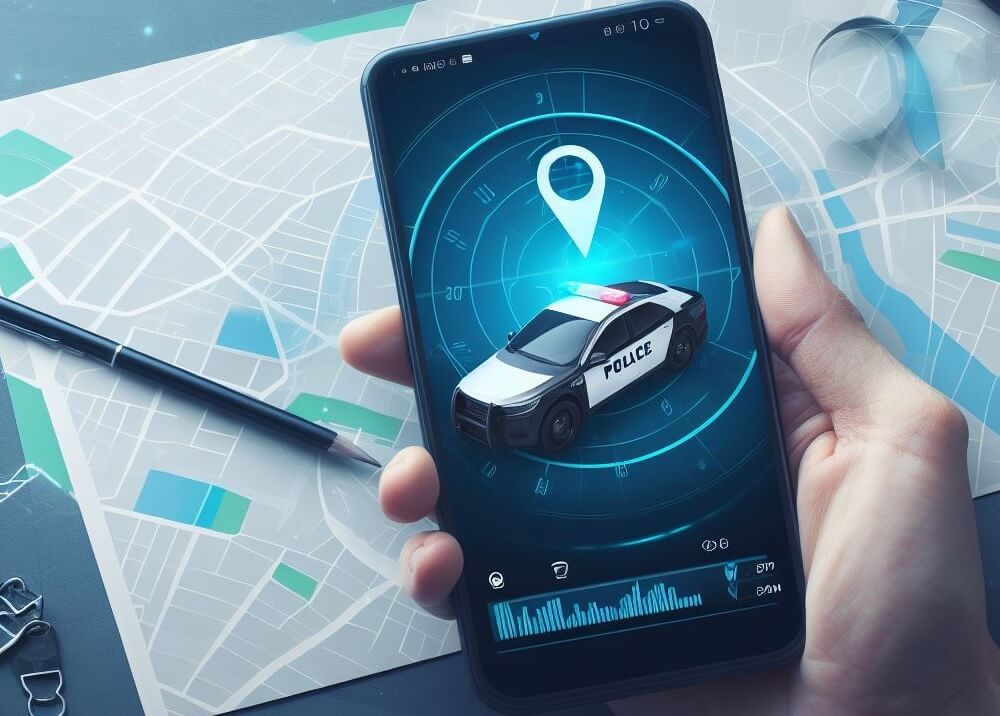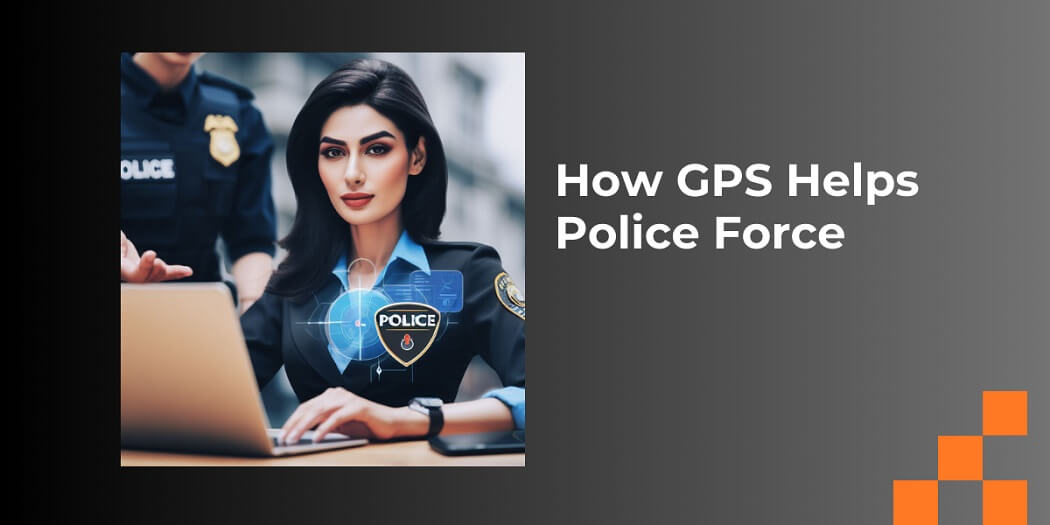Have you ever wondered how the police force can track down criminals in real time, no matter where they are? The answer lies in GPS technology. GPS, or Global Positioning System, is a satellite-based navigation system that enables the police force to track the location of vehicles, people, and even stolen property.
How GPS Helps the Police Force? Police departments use GPS technology to enhance their operations and keep communities safe. GPS devices aid officers in tracking criminal suspects, stolen vehicles, and missing persons. This technology also enables efficient dispatching and navigation, allowing police to respond to emergencies faster.
In this blog post, we’ll delve into the various ways in which GPS helps the police force, from improving response times to reducing crime rates. So if you’re curious about how GPS is revolutionizing law enforcement, keep reading.
Understanding GPS technology

Global Positioning System (GPS) technology has revolutionized the way we navigate our world. This satellite-based technology provides accurate location information, making it an essential tool for various industries, including law enforcement. GPS technology can help the police force in many ways, such as tracking suspects, locating stolen vehicles, and improving response times.
Definition and functionality of GPS
GPS is a global navigation satellite system that provides location and time information anywhere on or near the Earth where there is an unobstructed line of sight to four or more GPS satellites. The GPS consists of three parts: satellites orbiting the Earth, ground control stations, and GPS receivers.
The functionality of GPS is based on the principle of trilateration. GPS satellites continuously broadcast signals containing their location and the exact time the signals were transmitted. GPS receivers on the ground receive these signals and use them to determine their distance from the satellites.
By calculating the time it takes for the signal to travel from the satellite to the receiver, the GPS receiver can determine the distance between them. By receiving signals from at least four GPS satellites, the GPS receiver can accurately determine its precise location.
Types of GPS technology available
There are various types of GPS technology available for use in law enforcement. Some of them include:
- Handheld GPS devices: Handheld GPS devices are portable and easy to use. They can provide location information and maps, making them ideal for search and rescue operations, tracking suspects, and finding crime scenes.
- Vehicle-mounted GPS systems: These GPS systems are installed in police vehicles and can provide real-time location data to dispatchers, helping to improve response times and optimize patrol routes.
- GPS ankle monitors: These are used to track the movements of suspects or offenders on probation or parole. GPS ankle monitors can alert law enforcement if the person leaves their designated area, violating their terms of release.
How GPS technology works
GPS technology works by using a network of satellites to triangulate the location of a GPS receiver. When a GPS receiver receives signals from at least four GPS satellites, it can determine its precise location on Earth.
Each GPS satellite broadcasts signals that contain information about the satellite’s location, time, and other data. The GPS receiver receives these signals and calculates the distance between itself and the satellites based on the time it takes for the signals to reach the receiver.
Once the GPS receiver has determined its distance from the four satellites, it uses a process called trilateration to determine its precise location. Trilateration involves finding the intersection point of spheres, with the satellites’ signals representing the sphere’s center and radius. The intersection point is the GPS receiver’s precise location on earth.
Understanding GPS technology, its functionality, the types available, and how it works can help police officers make the most of this valuable resource.
Role of GPS in the police force

GPS technology has revolutionized the way law enforcement agencies operate, providing them with a powerful tool for tracking, monitoring, and responding to criminal activities.
GPS, or Global Positioning System, is a satellite-based navigation system that allows officers to pinpoint the location of criminals, vehicles, and even hotspots for criminal activity.
GPS for Tracking Criminals
GPS technology has proven to be a valuable asset in tracking down and apprehending criminals.
Law enforcement agencies can place GPS trackers on the vehicles of known criminals, allowing them to monitor their movements and gather evidence.
This technology has been particularly useful in cases involving drug trafficking, organized crime, and human trafficking, where suspects often use vehicles to transport illegal goods and people.
GPS for Locating Stolen Vehicles
One of the most common uses of GPS technology in law enforcement is for locating stolen vehicles. By installing GPS tracking devices in patrol cars, officers can quickly locate stolen vehicles and recover them.
GPS technology can also help in cases where suspects use stolen vehicles to commit crimes. By tracking the vehicle’s movements, officers can identify potential suspects and build a case against them.
GPS for Identifying Crime Hotspots
GPS technology can also be used to identify crime hotspots or areas where criminal activity is more likely to occur.
By analyzing crime data and GPS location data, police forces can identify patterns and trends in criminal activity, allowing them to allocate resources more effectively. This can help in preventing crime and reducing the overall crime rate in a given area.
GPS for Improving Response Time
Finally, GPS technology can help police forces improve their response time to emergencies.
By using GPS to track the location of patrol cars and other emergency vehicles, dispatchers can quickly dispatch the nearest available unit to the scene of a crime or accident. This can help save valuable time in emergency situations and potentially save lives.
Benefits of using GPS for police force
The use of Global Positioning System (GPS) technology has significantly transformed the way the police force operates.
GPS devices allow law enforcement agencies to track and monitor police vehicles, personnel, and assets in real-time, leading to numerous benefits in terms of increased efficiency, reduced crime rates, cost-effectiveness, improved officer safety, and better accountability.
Increased efficiency in policing
One of the primary benefits of using GPS for the police force is increased efficiency. GPS technology allows police departments to monitor and track the location of their officers, vehicles, and equipment in real time, enabling them to dispatch the closest available officer to a scene quickly. This leads to faster response times, improved incident management, and more efficient use of resources.
Reduced crime rate
Another significant benefit of using GPS technology in policing is the ability to reduce crime rates.
GPS enables police departments to conduct targeted patrols in high-crime areas, track the movement of suspects, and monitor known criminal activity hotspots. This allows them to prevent crimes before they occur, respond quickly to incidents, and apprehend suspects more efficiently.
Cost-effectiveness
GPS technology also offers cost-effectiveness benefits to police departments. By monitoring and optimizing the use of resources such as patrol vehicles, officers, and equipment, police departments can reduce operating costs, increase productivity, and optimize resource allocation.
Additionally, GPS technology can help reduce overtime expenses and fuel consumption by providing efficient routes for officers to take.
Improved officer safety
The use of GPS technology in policing also improves officer safety. GPS devices can help locate and rescue officers who may be in distress, and the real-time tracking of patrol vehicles can help monitor their speed and driving behavior.
GPS can also assist in identifying officers who may be lost or disoriented, reducing the risk of accidents or injury.
Better accountability
Finally, GPS technology provides better accountability for police departments. The real-time monitoring of patrol vehicles and officers allows for improved oversight and accountability, reducing the risk of misconduct or abuse of power.
GPS tracking can also provide valuable evidence in cases where officer conduct is under scrutiny, ensuring that the truth is upheld and justice is served.
Challenges of using GPS for police force
While GPS technology has revolutionized the way police forces operate, it comes with its own set of challenges. From privacy concerns to technical difficulties, limited resources and budget, and resistance from officers, these challenges can hinder the effectiveness of GPS in policing.
Privacy Concerns
One of the biggest challenges of using GPS for policing is privacy concerns. GPS technology allows the police to track the location of suspects, vehicles, and even their officers. This raises questions about privacy and civil liberties. Some people argue that GPS tracking violates their right to privacy and that it can be used to harass or intimidate individuals.
To address these concerns, police departments have implemented policies to ensure that GPS tracking is used only in specific situations, such as when there is a warrant or in emergencies. They also have to ensure that the data collected is kept confidential and is only accessible to authorized personnel.
Technical Difficulties
Another challenge of using GPS for policing is technical difficulties. GPS technology relies on satellite signals, which can be affected by environmental factors such as weather conditions, buildings, and terrain. This can lead to inaccurate location data or even loss of signal.
To overcome these challenges, police departments need to invest in reliable and up-to-date GPS equipment and ensure that officers are properly trained on its use. They also need to have backup systems in place in case of equipment failure or loss of signal.
Limited Resources and Budget
Police departments often face limited resources and budget constraints, which can make it challenging to implement and maintain GPS technology. The cost of purchasing and maintaining GPS equipment and software can be significant, especially for smaller departments.
To address this challenge, police departments can explore partnerships with other agencies or seek funding from government or private sources. They can also prioritize the use of GPS technology in high-priority cases or areas with high crime rates.
Resistance from Officers
Finally, some officers may be resistant to using GPS technology in their work. They may feel that it is intrusive or that it undermines their ability to do their job effectively. They may also be concerned about the potential for technology failure or hacking.
To address this challenge, police departments need to communicate the benefits of GPS technology to their officers and provide training on its use.
They also need to ensure that officers are involved in the decision-making process when it comes to implementing GPS technology and that their concerns are taken into consideration. By addressing these challenges, police departments can use GPS technology effectively and efficiently to improve public safety.
Challenges of using GPS for police force
While GPS technology has revolutionized the way the police force operates, it is not without its challenges. To understand how GPS helps Police forces, we need to understand the challenges faced by them.
Privacy concerns
One of the most significant concerns with the use of GPS technology by the police force is privacy. GPS tracking can be seen as an invasion of privacy, and many people are uncomfortable with the idea of being monitored by law enforcement.
To address these concerns, police departments must establish clear policies and guidelines for the use of GPS tracking. It is important to ensure that officers are only using GPS technology when it is necessary and justified and that the information collected is only used for legitimate law enforcement purposes.
Technical difficulties
GPS technology can be complex, and technical difficulties can arise when using it for law enforcement purposes. For example, GPS tracking devices may malfunction or fail to provide accurate location data.
Additionally, using GPS tracking can be hampered by environmental factors such as tall buildings or bad weather. To address these challenges, police departments must invest in high-quality GPS tracking equipment and provide proper training to officers on how to use it effectively.
Limited resources and budget
Police departments are often faced with limited resources and budget constraints, which can make it difficult to implement and maintain GPS technology. GPS tracking devices can be expensive, and the cost of maintaining them can add up quickly.
To address these challenges, police departments can consider partnering with other agencies or organizations to share the cost of GPS technology. Additionally, they can prioritize the use of GPS tracking in high-risk or high-priority cases to maximize the impact of their investment.
Resistance from officers
Finally, some police officers may be resistant to the use of GPS technology. Officers may feel that GPS tracking is intrusive or may be concerned about privacy issues.
To address these concerns, police departments can provide training and education to officers about the benefits and limitations of GPS tracking. They can also involve officers in the development of policies and guidelines for GPS use so that they have a say in how the technology is used in their department.
Best practices for using GPS in policing
GPS technology has revolutionized the way law enforcement operates by providing real-time location tracking of police vehicles, equipment, and even individuals. While GPS has proven to be a valuable tool for the police force, there are certain best practices that should be followed to ensure its effective use.
Proper Training for Officers
One of the most important best practices for using GPS in policing is to ensure that officers receive proper training on the technology. GPS can be a complex tool, and officers need to understand how to use it effectively and interpret the data it provides.
Police departments should provide thorough training to their officers on how to use GPS devices and software, including how to properly input data, read maps, and troubleshoot any issues that may arise.
Clear Policies and Guidelines
In addition to training, clear policies and guidelines should be established regarding the use of GPS technology in policing. These policies should outline the permissible uses of GPS technology, the criteria for initiating GPS tracking, and the steps that officers should take when using GPS to avoid infringing on individual privacy rights.
Clear policies and guidelines can help to prevent misuse of the technology and ensure that its use is consistent with legal and ethical standards.
Regular Maintenance and Updating of Technology
GPS technology requires regular maintenance and updating to ensure that it remains reliable and accurate. Police departments should establish a system for regular maintenance and updating of their GPS devices and software to avoid malfunctions and errors.
This can include routine inspections, software updates, and hardware replacements as needed. Regular maintenance and updating of technology can help to ensure that GPS remains a valuable tool for the police force.
Collaboration with Community Members
Finally, collaboration with community members is an important best practice for using GPS in policing. Police departments should engage with community members to explain the use of GPS technology, address concerns about privacy and data security, and foster trust and transparency. Collaborating with community members can help to ensure that the use of GPS technology in policing is consistent with community values and priorities.
Proper training for officers, clear policies and guidelines, regular maintenance and updating of technology, and collaboration with community members can all contribute to the responsible and effective use of GPS in law enforcement.
Conclusion
GPS technology helps police in multiple ways. It enables officers to track suspects and stolen vehicles in real time. GPS devices can also provide valuable data during investigations, such as the movements of suspects or vehicles involved in a crime.
In conclusion, GPS technology has revolutionized the way police forces operate, enabling them to enhance their efficiency, safety, and effectiveness. With real-time location data, police officers can respond quickly to emergencies, track suspects, and recover stolen property. They can also better plan and manage their operations, reducing response times and improving resource allocation.
The use of GPS technology has not only improved policing but also helped to build trust between the police force and the community they serve. By providing accurate and transparent information about their activities, police departments can demonstrate their commitment to public safety and accountability.
As technology continues to evolve, there is great potential for GPS to further enhance policing. For instance, the integration of GPS with other technologies like facial recognition and artificial intelligence could provide even more valuable insights and capabilities for law enforcement agencies.
However, it is also essential to recognize the potential risks and ethical concerns associated with the use of GPS technology in policing. Ensuring appropriate safeguards and oversight is crucial to avoid abuse of power and protect civil liberties.
In summary, the benefits of GPS technology for the police force are clear. By leveraging this powerful tool, law enforcement agencies can enhance public safety, build trust, and improve their operations. With careful consideration and responsible use, GPS technology can continue to be a valuable asset for policing in the years to come.
